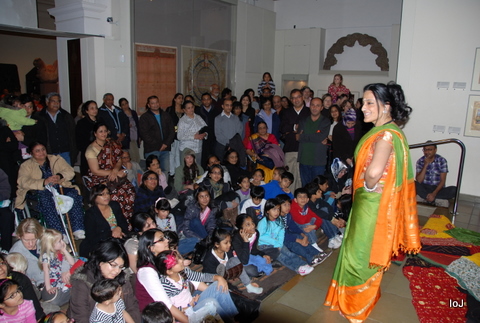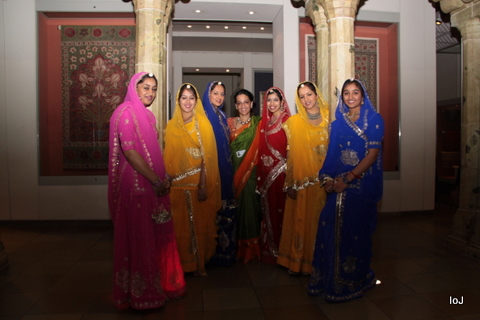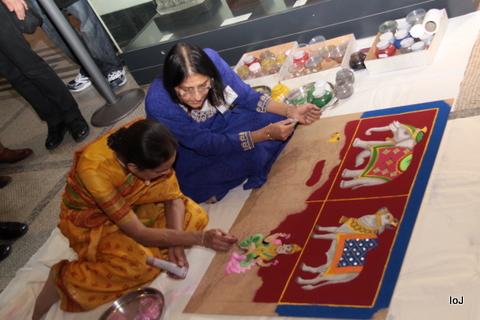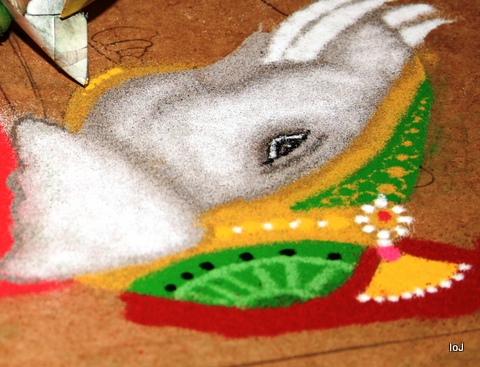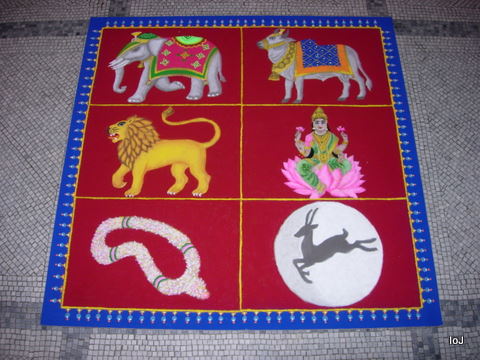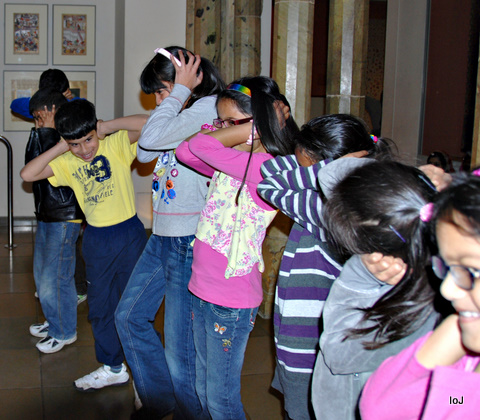JAINpedia celebrated Diwali at the Victoria and Albert Museum, South Kensington, London during the weekend of 13-14th November 2010. The day was fun filled with educational activities for children and families as well as those in search for more knowledge about the culture and heritage of Jainism.
The celebrations kicked off with Shobhna and Pratima Haria creating a large ‘Rangoli’. This is a a traditional decorative folk art of India. The purpose of Rangoli is decoration and it is thought to bring good luck. Design-depictions may also vary as they reflect traditions, folklore and practices that are unique to particular area. The base material is usually dry or wet granulated rice or dry flour, to which Sindhoor(vermillion), Haldi(tumeric) and other natural colours can be added. Shobhna and Pratima began their work of art, depicting 6 of the 14 dreams of Queen Trishala on Saturday morning and took 3 days to finish their masterpiece.
Their steady and skilled hands filled the drawings meticulously with coloured powder. JAINpedia volunteers were on hand to explain the significance of Rangoli and the relevance of the particular pictures.
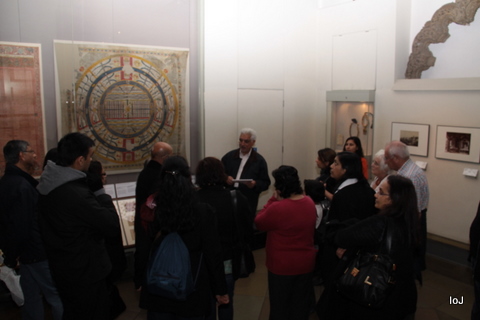
JAINpedia display tours were conducted by volunteers every hour through the 2 days with over 1000 people having viewed the display. The JAINpedia volunteers captivated their audiences with the explanation of the the history and contents of the display.
A large Jayatra yantra or Victory banner on display is believed to have been consecrated at Diwali in 1447. It is one of the oldest surviving dated Jain paintings on cloth and combines exquisitely delicate painting with the numerals and syllables which gave it its power as a yantra or esoteric diagram.
Jain monks have traditionally been supported by a much larger lay community, who gained spiritual merit by commissioning manuscripts, which were then preserved in temple libraries. The illustrated manuscript pages on display were made for the Shvetambara sect of Jains in Gujarat and Rajasthan. There are finely detailed pages of the 15th and 16th century manuscripts of the canonical Kalpasutra and Uttaradhyayanasutra texts. Some are opulently decorated with blue and gold pigment while others retain the vibrant red and fine line characteristic of the earlier part of this period. They tell the stories of the 24 Jinas (spiritual victors) revered by the Jains and several illustrate the principles of non-violence and respect for all forms of life that are at the heart of Jainism.
Conservation of the Jain manuscript pages involved special research and treatment which avoids the use of animal glues in accordance with Jain principles. A series of fascinating illustrations from cosmological manuscripts chart the changes in Jain paintings in the 17th and 18th centuries. Finally, a large but highly detailed painting made in 1844 in Deshnok, Rajasthan, shows the Middle World of the Jain universe, where mortals dwell, and its intriguing island continents and seas. Very fragile, and bearing the scars of severe historical damage, it was specially conserved for the display.
On Sunday, the Victoria & Albert Museum organized a Diwali themed treasure hunt for the visitors. Families explored the galleries to find objects related to the story of Queen Trishala’s 14 dreams. They were given digital cameras by the museum, then worked with the museum’s digital artists to create a digital collage from their pictures illustrating their own dream story.
The highlight of the weekend was the two story-telling sessions by Seema Anand. Seema is a passionate and inspiring story teller. Whether her listeners are 9years or 90years, she has the capacity to transport them into her story world and hold them there. Story, according to Seema, is a physical skill and a visual art and her work is developed to include alternative aesthetic and cultural perspectives for all ages and capacities. The Nehru Gallery, where the story-telling took place was filled to the brim, and music from the dancers supporting the story-telling echoed in the galleries. The children were invited to take part in the story-telling making the event interactive and amusing for all. Seema’s stories were taken from the newly published ‘Jain Tales’ by Colin Hynson, a publication by the Institute of Jainology.
